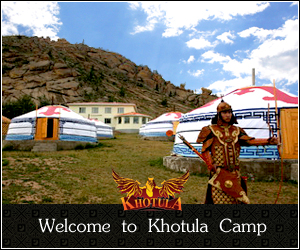Tsam Mask Dancing
 It is worth mentioning the traditional religious ritual dance “Tsam ” as an internationally popular Mongolian performance. It is an ancient mixture of theater, dancing, ritual ceremony and of folk tales. Its uniqueness had been highly appreciated in Great Britain, Germany, France, Skandinavian countries and many other parts of the world.
It is worth mentioning the traditional religious ritual dance “Tsam ” as an internationally popular Mongolian performance. It is an ancient mixture of theater, dancing, ritual ceremony and of folk tales. Its uniqueness had been highly appreciated in Great Britain, Germany, France, Skandinavian countries and many other parts of the world.
The ancient religious mask dance, or Tsam, is a significant religious ritual which reflects Buddhist teachings through images. It is a theatrical art performed by skilled dancers wearing magnificently ornamented costumes, which represent characters of different holy figures and devils, animals, and people.
Tsam mask dancing is included in the art form called “Doigar”, which  embodies independent imagination, one of the ten kinds of wisdom according to ancient Indian philosophy. The Tsam dance ceremony was first introduced to Mongolia in the 8th century, when the famous Indian Saint Lovon Badamjunai was invited to Mongolia to sanctify the construction of the first Tibetan Buddhist temple, Samya.
embodies independent imagination, one of the ten kinds of wisdom according to ancient Indian philosophy. The Tsam dance ceremony was first introduced to Mongolia in the 8th century, when the famous Indian Saint Lovon Badamjunai was invited to Mongolia to sanctify the construction of the first Tibetan Buddhist temple, Samya.
From that time, the Tsam dance was performed following the traditional teaching of Nyambdeyan, and during the 16th century, it became popular in Dashlhum temple Uigien Namjra and other places. Eventually, more than 500 monasteries of the 700 Mongolian monasteries had their own local variations of the ceremony.
There were two kinds of tham dances. Mil Bogdo or Talking Tsam died out, but the Geser tsam, famous for its elaborately rich decorations, remained. An example of the Geser tsam was the most popular tsam in Mongolia, the “Jahar tsam” or “Erleg Nomun Khan Tsam”. It was first performed in 1811, and told the story of how the disciple Yamandag destroyed the aggressive Erlegs’ metallic citadels, thus taming them.
In Khuree Tsam or the “Tsam of the Erleg Nomun Khan”, a total of 108 costumes are worn, including 21 disciples and deities, such as Conger, Namarari, Combo, Ochirvaany, Jamsran, Lham, and Damdinchoijoo. This tsam was staged every year on the 9th day of the last summer month, and was an important ceremony.
The person who choreographed the first tsam dance after the establishment of Erdene-Zuu monastery in Karakorum (Genghis Khan’s capital city) was a Mongolian. Folk art and native wisdom played an important role in the production of the individual Tsam dances. Song and dance, music, decorative arts, and other kinds of folk art are included in the Tsam ceremony.
Despite the fact that the Mongolian Tsam dance was based on Indian folk art and was popularized in Tibet, it was highly developed in Mongolia. For this reason the Mongolian-Tibetan tsam dance, the Geser and Nomun Khan fancy-dress tsam, and Mil Bogdo’s Talking Tsam will have a permanent position in the history of the world’s theater arts.













sain baina uu
Bid german 3 hun mongol 2 hun Tsam iin jihene togloltiig uezeh huseltei ban iimees 2010 ond haana hezee bolohiig helj ugnu uu
tsamin bvjig 7r sariin 30nd ulaanbaatart dashchoinkhorlon xiided mun amarbaysgalan xiided 8-9 sariin xoorond bolno
Hi everybody who is interested in coming to Mongolia.
I am an experienced guide and i can organized all kinds of tour in Mongolia. I am especially exprienced in the field of horse trekking, hiking and cycling. if you need more information please contact me.I am always happy to help you all.
The land of the blue sky bless you!
Just wanted to say thanks for the informative article, I was researching Mongolian festivals and stumbled upon this great piece on Tsam dancing. Love it